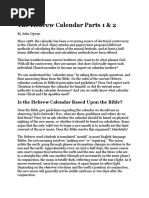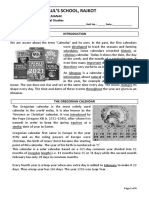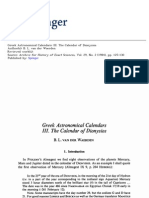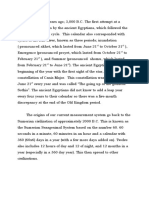Oracle Dates
Uploaded by
rockerabc123Oracle Dates
Uploaded by
rockerabc123My thanks to Claus Tøndering for permission to quote the following from his excellent paper,
“Frequently Asked Questions about Calendars, v2.3”. The full document is available at
http://www.tondering.dk/claus/calendar.html. Thoroughly recommended.
Ever wondered why the Oracle date format has such a weird starting point, 4713 BC? And ever
wondered whether it faces a ‘running out of dates’ issue, such as we (nearly) experienced with the
Y2K problem? Read on, and all will become clear. Oracle actually uses the “Julian Period”, but to
understand what that is, you need to know three other pieces of information… .
What is the Solar Cycle?
In the Julian calendar, the relationship between the days of the week and the dates of the
year is repeated in cycles of 28 years. In the Gregorian calendar, this is still true for periods
that do not cross years that are divisible by 100 but not by 400.
A period of 28 years is called a Solar Cycle. The Solar Number of a year (ie, which Solar Cycle
it’s in) is found as:
Solar Number = (year + 8) mod 28 + 1
In the Julian calendar, there is a one-to-one relationship between the Solar Number and the
day on which a particular date falls.
What is the Golden Number?
Each year is associated with a Golden Number.
Every 19 years, the phases of the moon fall on the same dates (if it were not for the skewness
introduced by leap years). It is therefore natural to associate a number between 1 and 19
with each year. This number is the so-called Golden Number. It is calculated thus:
Golden Number = (year mod 19) + 1
In years which have the same Golden Number, the new moon will fall on (or very nearly on)
the same date.
What is the Indiction?
The Indiction was used in the middle ages to specify the position of a year in a 15 year
taxation cycle. It was introduced by emperor Constantine the Great on 1 September 312 and
ceased to be used in 1806.
The Indiction may be calculated thus:
Indiction = (year+2) mod 15 + 1
The Indiction has no astronomical significance.
The Indiction did not always follow the calendar year. Three different Indictions may be
identified:
1. The Pontifical or Roman Indiction, which started on New Year’s Day (being either 25
December, 1 January or 25 March).
2. The Greek or Constantinopolitan Indiction, which started on 1 September.
3. The Imperial Indiction, or Indiction of Constantine, which started on 24 September.
What is the Julian Period
The Julian Period (and the Julian day number) must not be confused with the Julian calendar
(i.e., the calendar introduced in 45 BC by Julius Caesar).
The French scholar Joseph Justus Scaliger (1540-1609) was interested in assigning a positive
number to ever year without having to worry about BC and AD. He invented what is today
known as the Julian Period.
The Julian Period probably takes its name from the Julian Calendar, although it has been
claimed that it is named after Scaliger’s father, the Italian scholar Julius Caesar Scaliger
(1484-1558).
Scaliger’s Julian Period starts on 1 January 4713 BC and lasts for 7980 years. AD 2000 is thus
year 6713 in the Julian Period. After 7980 years, the number starts from 1 again.
Why 4713 BC, and why 7980 years? Well, in 4713 BC the Indiction, the Golden Number and
the Solar Number were all 1. The next time this happens is 15 x 19 x 28 = 7980 years later, in
AD 3268 [at which point Oracle databases with date fields will cease to function properly!!]
Astronomers [and RDBMS developers] have used the Julian period to assign a unique number to
every day since 1 January 4713 BC. This is the so-called Julian Day. JD 0 designates the 24
hours from noon UTC on 1 January 4713 BC to noon UTC on 2 January 4713 BC.
This means that at noon UTC on 1 January AD 2000, JD 2,451,545 started.
This can be calculated thus:
From 4713 BC to AD 2000 there are 6712 years.
In the Julian calendar, years have 365.25 days, so 6712 years corresponds to 6712 x 365.25 =
2,451,558 days. Subtract from this the 13 days that the Gregorian calendar is ahead of the
Julian calendar, and you get 2,451,545.
Often fractions of Julian day numbers are used, so that 1 January AD 2000 at 15:00 UTC is
referred to as JD 2,451,545.125.
Note that some people use the term “Julian day number” to refer to any numbering of days.
NASA, for example, uses the term to denote the number of days since 1 January of the
current year.
You might also like
- Federalization of Solid Waste in MalaysiaNo ratings yetFederalization of Solid Waste in Malaysia13 pages
- The History of Calendar: Supervisor: Torben BraünerNo ratings yetThe History of Calendar: Supervisor: Torben Braüner57 pages
- Greek Astronomical Calendars III. The Calendar of Dionysios by B. L. Van Der WaerdenNo ratings yetGreek Astronomical Calendars III. The Calendar of Dionysios by B. L. Van Der Waerden7 pages
- Creation Day Number - Enoch Solar CalendarNo ratings yetCreation Day Number - Enoch Solar Calendar3 pages
- The Millerites Full Year No Zero Year-1No ratings yetThe Millerites Full Year No Zero Year-118 pages
- What Is So Right About The Hindu CalendarNo ratings yetWhat Is So Right About The Hindu Calendar9 pages
- 0 (Year) : Counting Intervals Without A ZeroNo ratings yet0 (Year) : Counting Intervals Without A Zero9 pages
- The Inca Calendar, The Ceque System, and Their Representation in100% (1)The Inca Calendar, The Ceque System, and Their Representation in30 pages
- The Ethiopic Calendar - Dr. Aberra MollaNo ratings yetThe Ethiopic Calendar - Dr. Aberra Molla8 pages
- Origin of The Calendar and The Church YearNo ratings yetOrigin of The Calendar and The Church Year7 pages
- The Calendars of Imladris, Gondor and The Shire and Their Adaptation For Gregorian ReckoningNo ratings yetThe Calendars of Imladris, Gondor and The Shire and Their Adaptation For Gregorian Reckoning8 pages
- Astronomical Algorithms Amended Multi-Millennia CANo ratings yetAstronomical Algorithms Amended Multi-Millennia CA4 pages
- Historical Financial Statistics: Calendar NotesNo ratings yetHistorical Financial Statistics: Calendar Notes13 pages
- The Calendars of Ancient Egypt: BCE BCENo ratings yetThe Calendars of Ancient Egypt: BCE BCE22 pages
- Chinese Calendar: From Wikipedia, The Free EncyclopediaNo ratings yetChinese Calendar: From Wikipedia, The Free Encyclopedia18 pages
- Calendar 101 - What in The World Is A Covenant Calendar (5 PGS) June 2020No ratings yetCalendar 101 - What in The World Is A Covenant Calendar (5 PGS) June 20205 pages
- Schrag - Oracle 8i To 10g Upgrade Case StudyNo ratings yetSchrag - Oracle 8i To 10g Upgrade Case Study86 pages
- Velikanovs - Performance Tuning and Troubleshooting For Oracle OC4J (Slides - Long Version)No ratings yetVelikanovs - Performance Tuning and Troubleshooting For Oracle OC4J (Slides - Long Version)83 pages
- Velikanovs - Performance Tuning and Troubleshooting For Oracle OC4J100% (2)Velikanovs - Performance Tuning and Troubleshooting For Oracle OC4J35 pages
- Breitling - Histograms, Myths and Facts OracleNo ratings yetBreitling - Histograms, Myths and Facts Oracle42 pages
- Oracle - Tablespace Locally Management TablespacesNo ratings yetOracle - Tablespace Locally Management Tablespaces3 pages
- PDF of A Scot in The Dark Sarah Maclean Full Chapter Ebook100% (12)PDF of A Scot in The Dark Sarah Maclean Full Chapter Ebook69 pages
- MDCT: Technical Principles and Future Trends: Mathias ProkopNo ratings yetMDCT: Technical Principles and Future Trends: Mathias Prokop8 pages
- Fm/Am Compact Disc Player: CDX-G1280UM/CDX-G1201U/CDX-G1200U/ CXS-G1269U/CXS-G124SU/CXS-G1216UNo ratings yetFm/Am Compact Disc Player: CDX-G1280UM/CDX-G1201U/CDX-G1200U/ CXS-G1269U/CXS-G124SU/CXS-G1216U56 pages
- Cuenca Pativilca: Precipitación Promedio Mensual Por Año Medida en La Estación Aco, 1963-86 (Milímetros)No ratings yetCuenca Pativilca: Precipitación Promedio Mensual Por Año Medida en La Estación Aco, 1963-86 (Milímetros)5 pages
- Immune System Song - Ben Kany and John BarbackNo ratings yetImmune System Song - Ben Kany and John Barback3 pages
- Practical A5 Stoke' S Law and Viscosity of Oil.No ratings yetPractical A5 Stoke' S Law and Viscosity of Oil.7 pages
- Sistema de Riego Automático Con ArduinoNo ratings yetSistema de Riego Automático Con Arduino12 pages
- Bilston Urban Village SPD Complete DocumentNo ratings yetBilston Urban Village SPD Complete Document74 pages
- Shoulder and Elbow Trauma and Its Complications Volume 2 The Elbow Woodhead Publishing Series in Biomaterials 1st Edition Michael Greiwe100% (3)Shoulder and Elbow Trauma and Its Complications Volume 2 The Elbow Woodhead Publishing Series in Biomaterials 1st Edition Michael Greiwe62 pages
- Arch - Part01 - Lot 1-2 - 31 Herrick ST, MT Gravatt - Rev A2 - BR20230304No ratings yetArch - Part01 - Lot 1-2 - 31 Herrick ST, MT Gravatt - Rev A2 - BR202303048 pages







































































































